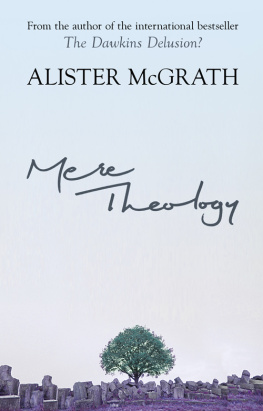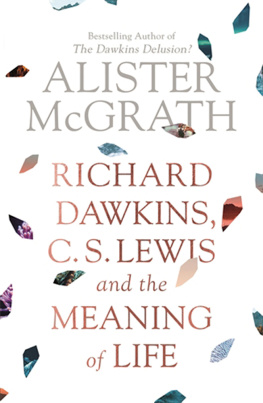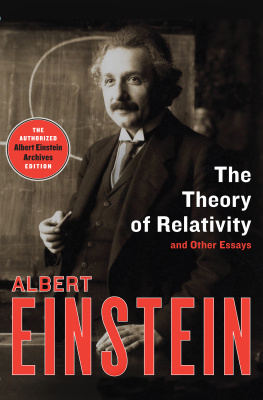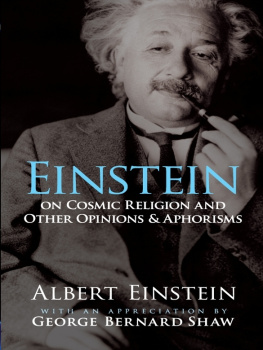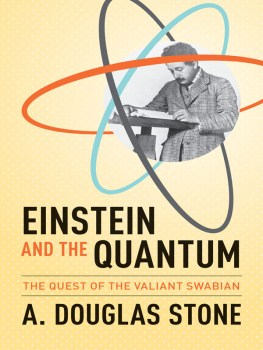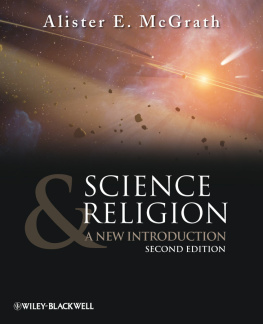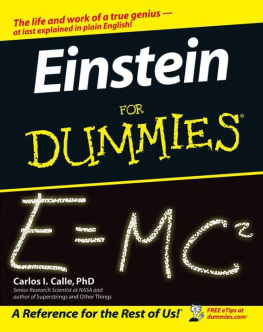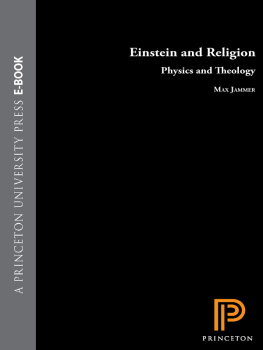Praise for
A Theory of Everything (That Matters)
This brief book provides an answer to those who wonder, What is the value of religion in a modern scientific world? McGrath gives an accessible introduction to Einsteins science, then reflects on how the great physicist synthesized politics, ethics, science, and religion in his view of the world. Einstein felt that, while science can help us achieve our moral goals, science alone cannot create those moral goals or the means to instill them in society. McGrath shows that we need both religion and science to best engage the mysteries of the world and everything that matters.
DEBORAH HAARSMA
Astrophysicist and president of BioLogos
Albert Einstein was, without doubt, the most iconic scientist of the last century. In this lucid little book, Alister McGrath provides an accessible introduction to Einsteins great scientific discoveries, as well as a careful analysis of his views on the relationship between science and religion. Einstein was a nuanced thinker on the big questions of life, and who better than McGrath to guide us on an exploration of this aspect of Einsteins legacy? I recommend this book to anyone who wants a fuller picture of Albert Einsteins life and thought.
ARD LOUIS
Professor of theoretical physics, University of Oxford
Visit Tyndale online at www.tyndale.com.
Visit Tyndale Momentum online at www.tyndalemomentum.com.
TYNDALE, Tyndales quill logo, and Tyndale Momentum are registered trademarks of Tyndale House Publishers, Inc. The Tyndale Momentum logo is a trademark of Tyndale House Publishers, Inc. Tyndale Momentum is the nonfiction imprint of Tyndale House Publishers, Inc., Carol Stream, Illinois.
A Theory of Everything (That Matters): A Brief Guide to Einstein, Relativity, and His Surprising Thoughts on God
Copyright 2019 by Alister McGrath. All rights reserved.
Cover illustration of Albert Einstein copyright by Naci Yavuz/Shutterstock. All rights reserved.
Personality rights of ALBERT EINSTEIN are used with permission of The Hebrew University of Jerusalem. Represented exclusively by Greenlight.
Interior illustrations by Ruth Pizzi, copyright Tyndale House Publishers, Inc. All rights reserved.
Designed by Ron C. Kaufmann
Edited by Jonathan Schindler
Scripture quotations are taken from the Holy Bible, New International Version, NIV. Copyright 1973, 1978, 1984, 2011 by Biblica, Inc. Used by permission. All rights reserved worldwide.
For information about special discounts for bulk purchases, please contact Tyndale House Publishers at , or call 1-800-323-9400.
ISBN 978-1-4964-3807-2
ISBN 978-1-4964-3810-2 (ePub); ISBN 978-1-4964-3809-6 (Kindle); ISBN 978-1-4964-3811-9 (Apple)
Build: 2019-09-23 14:56:58 EPUB 3.0
introduction : ALBERT EINSTEIN:
THE WORLDS FAVORITE
GENIUS
ALBERT EINSTEIN REMAINS the worlds favorite genius, propelled to fame by popular adulation of his revolutionary scientific theories about space and time. Today, a century after the confirmation of his theory of general relativity in November 1919, Einstein remains a cult figure. He has appeared on the cover of Time magazine no fewer than six times and was lionized as its Person of the Century in 1999. His equation E = mc has become the best-known scientific formula of all time and has regularly along with Einsteins trademark hairstyle found its way onto T-shirts and billboards.
Photographers loved Einstein. One of the best-known photos of him is Arthur Sasses shot of Einstein sticking out his tongue. This iconic photograph was taken right at the end of his birthday party in 1951 at Princeton, as a weary Einstein entered his chauffeured automobile to be driven home. Sasse, who had been covering the event, ran up to the open door and asked Einstein for one final shot. Einstein turned toward him and stuck out his tongue just as Sasses flashbulb went off. Einstein liked the resulting photo so much that he used it for greeting cards he sent to his friends.
Einsteins ideas have changed the way we think and live. Without realizing it, we depend on his theory of relativity when using a Global Positioning System (GPS). The light and warmth of the sun are the direct result of the conversion of mass to energy the process Einstein first recognized in 1905 and expressed in his equation E = mc. This same principle lies behind nuclear power generators and atomic bombs. Einstein triggered Americas race to build the atomic bomb in 1939 with a letter to President Franklin D. Roosevelt, warning him that Nazi Germany would get there first unless the United States committed itself to developing the necessary technology. (A copy of this typewritten letter was sold at Christies in New York for $2.1 million in 2008.)
The immense esteem in which Einstein was held by the academic and popular-science community meant that when he talked about larger questions, people were prepared to listen. When his theory of general relativity was triumphantly confirmed in November 1919, he became a media sensation. His 1921 tour of America was front-page news.
Yet Einstein did not simply speak about science. He opened up grander issues of human value and meaning what the philosopher Karl Popper later called ultimate questions. People listened to Einstein with attentiveness and respect. He became a celebrity genius, an intellect of colossal status, who managed to achieve iconic cultural status without dumbing down what he said.
Einstein doesnt fit the stuffy stereotype of a scientific genius. On a visit to California, he struck up a surprising friendship with the movie star Charlie Chaplin. Chaplin invited Einstein to attend the premiere of his 1931 movie City Lights. The huge crowd went wild as Einstein and Chaplin arrived together. According to a popular legend, Chaplin told Einstein, Theyre cheering you because nobody understands you, and me because everybody understands me. Although Einstein was awarded the 1921 Nobel Prize in Physics, his greatest achievement was arguably to become admired, even adored, by the wider public. Many sensed that although Einstein was difficult to understand, he had grasped something profound about our universe that others had failed to find. He was worth listening to even if doing so was difficult and demanding.
This short book sets out to explain in simple and accessible terms Einsteins revolutionary scientific ideas, which still shape our world today, and to explore their significance. Nobody thinks a scientific genius is infallible. Still, Einsteins status means he is profoundly worth listening to, especially when thinking about how we make sense of our universe.
Yet this book goes further as, I believe, Einstein would wish us to do. It takes seriously Einsteins fascination with a big picture of our world and ourselves. It considers how Einstein personally wove together science, ethics, and religious faith to yield a richer account of reality if you like, a theory of everything that matters. So how did he do this? What were the outcomes? What remains valuable for us today? Lots of people have written about Einsteins wider vision of life, stimulating and informing our discussion. So why not make Einstein our dialogue partner? After all, he was a genius.
Finally, a word of caution. Many sayings attributed to Einstein have no connection with him whatsoever. Heres one that is regularly attributed to Einstein, which I first came across on a T-shirt at an American university: Not everything that can be counted counts, and not everything that counts can be counted. Its a great idea but its not Einsteins. Throughout this book, I have tried to ensure reliable citation of Einsteins works. Heres an authentic quote that sets up the agenda of this book: Science can only ascertain what



